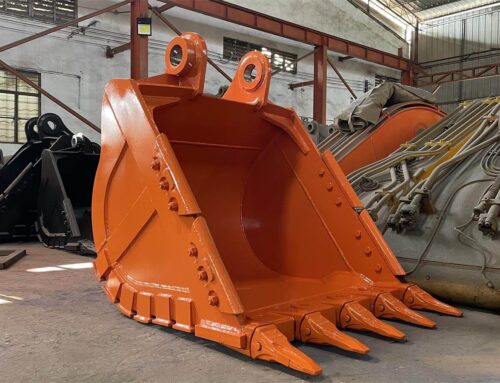Excavators are the workhorses of the construction and earthmoving industry, with their versatile capabilities to dig, lift, and move large quantities of soil, debris, and materials. Among the various attachments available for excavators, the excavator tilting bucket has emerged as a game-changer, revolutionizing the way operators handle excavation tasks. In this article, we will explore the key differences between tilting buckets and ordinary buckets, delving into their unique features, benefits, and the enhanced flexibility they offer in achieving precise and efficient earthmoving operations.
-
Understanding the Basic Functionality
Both excavator tilting bucket and ordinary buckets are primary attachments for excavators, designed to scoop and transport materials. Ordinary buckets feature a fixed connection to the excavator’s arm, limiting their range of motion to vertical digging and dumping. On the other hand, tilting buckets incorporate a hydraulic tilting mechanism that allows operators to tilt the bucket horizontally, typically up to 45 degrees in either direction. This pivotal function unlocks a range of advantages, making tilting buckets ideal for a variety of specialized applications.
-
Enhanced Flexibility and Precision
The tilting mechanism of excavator tilting bucket offers operators unprecedented control and precision during excavation tasks. By tilting the bucket, they can easily align it with uneven surfaces, sloping terrains, or precise grading requirements. This flexibility enables operators to achieve accurate and consistent digging angles, which is particularly useful in applications like ditching, landscaping, and slope finishing.
Moreover, the tilting function allows operators to maintain a level bucket even on sloping surfaces, preventing spillage and ensuring maximum material retention. This is crucial when working with loose or granular materials that may tend to slide or flow out of a fixed bucket.
-
Efficient Material Handling
Tilting buckets excel in handling various materials due to their ability to adapt to different contours and load conditions. When working in tight spaces or crowded job sites, tilting buckets provide an advantage by allowing operators to maneuver around obstacles and reach difficult-to-access areas more easily. The tilting function also facilitates efficient loading and unloading of materials, reducing spillage and minimizing rehandling.
Furthermore, the versatility of tilting buckets extends to the extraction of materials from vertical walls or trenches. By tilting the bucket horizontally, operators can effectively scrape material from vertical surfaces, reducing the need for additional tools and enhancing productivity.
-
Increasing Safety and Reducing Costs
Tilting buckets contribute to increased safety on excavation sites. Their ability to maintain a level bucket on sloping terrains helps prevent accidents caused by uneven loading or unstable material distribution. Additionally, by minimizing spillage and ensuring better control over materials, tilting buckets reduce the risk of falling debris or sudden shifts in the load.
Moreover, the flexibility of tilting buckets translates into time and cost savings. Operators can accomplish tasks that would typically require additional attachments or manual labor. By eliminating the need for frequent equipment changes or the employment of specialized personnel, projects can be completed more efficiently, leading to reduced operational expenses.
Conclusion
Excavator tilting buckets have revolutionized the field of earthmoving, empowering operators with enhanced flexibility and precision. By offering the ability to tilt horizontally, these attachments provide a level of control and adaptability that ordinary buckets simply cannot match. From achieving precise grading to maneuvering in tight spaces, tilting buckets prove their worth in a wide range of applications. With their potential to increase safety, improve efficiency, and reduce costs, tilting buckets have become an indispensable tool for operators seeking optimal performance in excavation projects.
-
Choosing the Right Attachment
When deciding between a excavator tilting bucket and an ordinary bucket for an excavation project, several factors should be considered. The choice largely depends on the specific requirements of the task at hand. If the project involves precise grading, working on slopes, or navigating confined spaces, a tilting bucket is the optimal choice. Its ability to adapt to varying terrains and maintain a level bucket offers superior control and efficiency.
On the other hand, ordinary buckets are more suitable for general digging and material handling tasks that do not require the same level of precision or flexibility. They are typically more cost-effective and may be the preferred option for projects with straightforward excavation needs.
It is worth noting that some excavators can be equipped with quick coupler systems, allowing for the easy interchangeability of different attachments. This versatility enables operators to switch between tilting buckets and ordinary buckets based on the specific requirements of each project, maximizing efficiency and productivity.
-
Future Developments and Innovations
The field of excavator attachments continues to evolve, and manufacturers are constantly striving to enhance the capabilities of excavator tilting bucket. Future developments may include improved hydraulic systems for smoother and faster tilting operations, as well as advanced control features for increased precision. Furthermore, advancements in material technologies may lead to the production of lightweight yet durable tilting buckets, optimizing fuel efficiency and machine performance.
Conclusion
Excavator tilting bucket have undoubtedly transformed the way earthmoving tasks are executed, offering operators a level of flexibility, precision, and efficiency that surpasses that of ordinary buckets. With their ability to adapt to varying terrains, maintain a level bucket, and handle materials with ease, tilting buckets have become a go-to attachment for many excavation projects. By carefully assessing project requirements and considering the advantages of tilting buckets, operators can make informed decisions to optimize their productivity, reduce costs, and achieve outstanding results in the ever-evolving field of earthmoving.








Leave A Comment